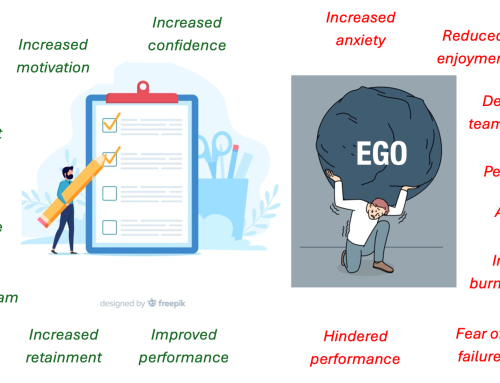If you ask any sample of people, some believe leaders are born while some believe leaders are made. Just as many more may feel that leaders are a bit of both – born and made. The reality is:
Leadership is a complex phenomenon.
Successful leadership comprises of many different components, ranging from attributes of the leader themselves (e.g., social, punctual, authoritative), the environment the leader creates, and the culture which the leader aims to instil throughout the team.
However, one thing that leadership is NOT – leadership is not management, just as management is not leadership. While similar, and certainly aspects of both can lend themselves to the other, the distinguishing factor is that leadership focuses upon individuals. Leadership involves influencing and guiding individuals towards a common, collective goal. Leaders rely upon inspiration, rather than demands – the weapon of choice of managers.
Managers march from the front and delegate, while leaders push from the back.
Quoting Steve Jobs;
‘Management is about persuading people to do things they don’t want to do, while leadership is about inspiring people to do things they never thought they could’.
Believing that leaders are born is an easy explanation, and frankly disregards the efforts of those who make a conscious decision to develop their leadership skills. While leadership is complex, it doesn’t mean that those wanting to cannot develop their skills. But first, one must have a perception of the styles of leadership commonly found.
Styles of Leadership
Sir Alex Ferguson, Nelson Mandela, Elizabeth II, and the previously mentioned Steve Jobs. Four completely different individuals, four as equally different leaders. Plenty of research has been conducted which tells us that there are many different approaches to leadership, with each style having a distinctive outlook on how to get the best out of those around them. So much so that I could write a full blog on each one and still be here next year.
As a result, below you will find a summary of the most influential, major styles of leadership you may be able to relate to, and what you would expect from each one.
Lewin’s Leadership Styles
- Autocratic – a leader which makes all the key decisions without consulting others, and one motivated to complete the task in hand as quickly and effectively as possible. This style is seen to be authoritarian and doesn’t tend to take others’ opinions or preferences into account. Often, it can lead to demoralisation, absenteeism, and even high staff turnover.
- Democratic – While these leaders tend to make the final decision, they include the team in the process – encouraging creativity, ownership, and unity across the team at the expense of speed and efficiency. The team may feel more motivated and rewarded from this resulting in higher job satisfaction, greater productivity, and a sense of common purpose.
- Laissez-Faire – These leaders tend to give their team more freedom of thought and decision in how they do their work, while providing support and guidance if and when needed. This can happen automatically and can increase job satisfaction but can often lead to a loss of group direction if the team do not have the necessary knowledge, skills, or self-motivation to do their work. Often, this style of leadership is shown in managers who do not have control over their team or generally inadequate.
Other Styles
- Bureaucratic – Leaders who follow rules rigourously and expect their team to do so too. Expected to be found in roles with high safety risks (heavy machinery, biological products, etc) or high financial responsibility. These leaders are not effective in leading teams that rely upon creativity and flexibility.
- Servant – A servant leader is someone, not necessarily of a higher position, who leads simply by meeting the needs of the team and does not even need the formal recognition as leader. They have high integrity and demonstrate great generosity, driving team morale in a positive manner. While driven by values and ethics, this leader may not be suitable in a competitive environment as they may find themselves left behind by other, more competition-driven leaders.
The most effective style?
Well, while you now may be able to recognise your leadership style or recognise the style of a leader in your life, I hear you asking which one is the best style to lead with. It is at this point that I sit on the fence and tell you that this depends on the situation, the task in hand, and the team you have around you. Should a task be of high demand, and the work force prone to distraction but you only have a short deadline to complete, then a more autocratic style would be the likeliest to deliver the best result. A task that requires innovation and collaboration would benefit most from a democratic leader at the helm.
However, Transformational Leadership attempts to bridge this gap. While it is a distinct style within itself, it shares a great deal with other leadership styles in that they communicate well with the team, and set clear goals, but are also self-aware, empathetic, humble, and hold themselves accountable for their actions, which can lead to higher productivity and engagement.
The important characteristic of a transformational leader is that they adapt their leadership approach towards a specific situation. Their core characteristics remain consistent (empathetic, humble, accountability) but are flexible in the type of leadership they demonstrate dependent on the task in hand. In essence, leadership style is not a ‘one size fits all’ to any situation, and a good leader can adopt a different framework as necessary.
The do’s and do not’s
So, what can you do now to develop your leadership skills, whether this is as captain of your team or as head of a department/leader in an organisational setting?
Do
- Have a clear vision and goal and share it with the team – don’t for get WHY!
- Develop experience across as many roles within your organisation as possible to develop understanding of who experiences what in the team
- Trust people to carry out their own responsibilities – give them tasks that will challenge them but be there to provide guidance if needed
- Be prepared to do the work that you are asking of them – push from the back
- Approach situations with positivity and enthusiasm – watch this catch on across the team
- Develop an understanding of yourself as a leader, and the type of leader you wish to be – try reflective practice to do so
Do nots
- Focus solely upon yourself for personal gain
- Success at all costs – focusing solely on outcomes rather than the process and the team getting there can be damaging both short and long-term
- Act with malicious intent – dishonesty, deception, and deceit should be frowned upon
- Arrogant – a fine line exists between confidence and arrogance, and being on the side of arrogance should be discouraged. Arrogance can lead to pretentiousness, controlling behaviours, and rigid beliefs which stunts productivity
Final Thoughts
As a leader you are a facilitator, an inspirer, and instigator, and influencer, who is looked up to for guidance and support and of course leadership. A leader has influence on all of those who they are in direct contact with across the team, but also those with indirect contact can be influenced by your decisions, emphasising the importance of the role a leader has in ensuring that these contacts are as positive and productive as possible. From this, it is hoped that you can now understand the differences between a manager and leader, the different types of leadership, and are able to begin to think about how you can be an effective leader.
As always, get in touch and let me know your experiences of leaders you’ve met, or if you want to develop the skills to become an effective leader in your walk of life.





Leave A Comment